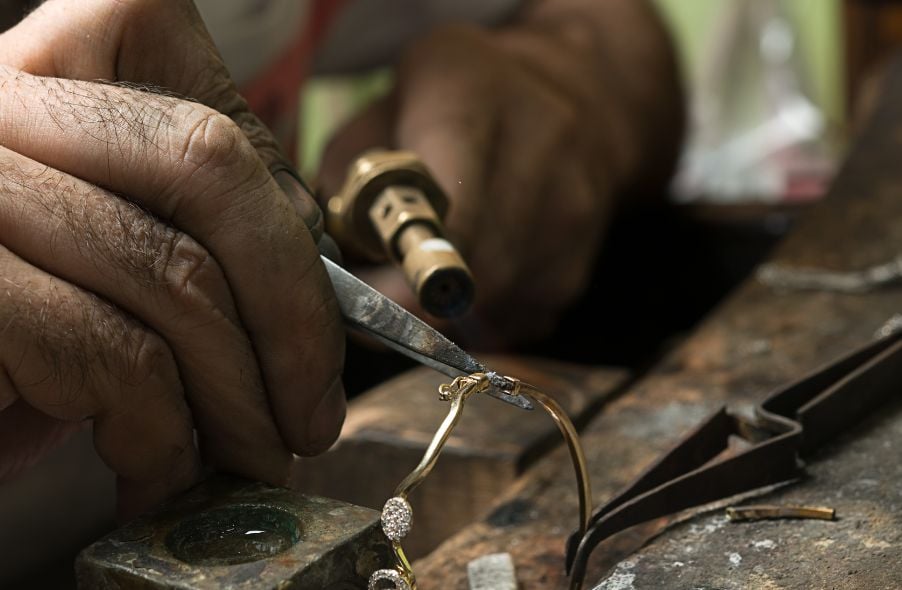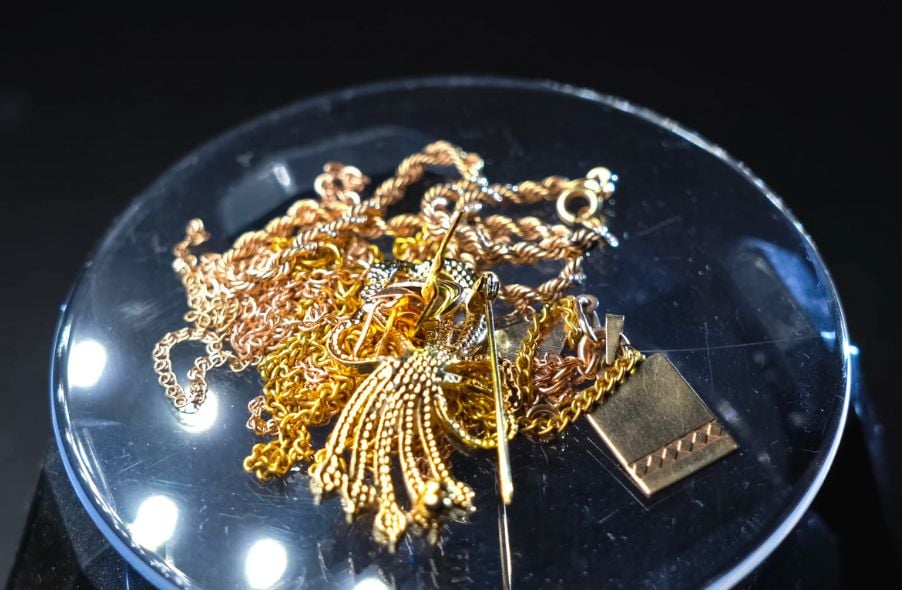
What Is Gold-Filled Jewelry?
When browsing for jewelry online, you may come across pieces that are described as gold-filled. Contrary to popular belief, this does not mean that the entire product is made of pure gold. Gold-filled jewelry actually contains two layers of gold mixed with other metals, such as brass or copper.
The process of making gold-filled jewelry involves chemically bonding either 12-karat or 14-karat gold to another metal using high-power machinery. This machine uses heat and pressure to bond a bottom layer of gold, a core layer of another metal, and a top layer of gold.
Jewelers measure gold purity in karats, with 24 karats signifying 100% solid gold. Gold-filled items with 12-karat gold have 50% pure gold in the precious metal alloy.
Making gold-filled jewelry is a complex process that can be costly and requires specialized machinery. Small jewelry stores may not have access to these machines and rely on mass-produced products. As a result, it can be more challenging to find gold-filled items in certain stores.
Retailers can only classify a piece as gold-filled if the gold layers make up at least 5% of the total metal content. These layers contribute to the overall thickness and durability of the item.
What Is Gold-Plated Jewelry?
Gold-plated jewelry features a layer of gold over another metal, such as sterling silver or brass. However, this option contains less gold and is more susceptible to tarnishing. The process of making gold-plated jewelry is different from gold-filled jewelry.
To create gold-plated jewelry, jewelers follow these steps:
- Gather gold pieces, a base metal, and a liquid electroplating solution.
- Soak the gold and base metal in the electroplating solution.
- Use a positive electric current to bond the two metals, with the gold receiving a positive current and the alloy metal receiving a negative current.
- Mold the piece into a stylish design.
This process is simpler for jewelers to perform on their own and allows for more freedom and creativity in their designs.

Composition and Durability of Gold-Filled Jewelry
Gold-filled jewelry is more durable compared to gold-plated jewelry. It won't tarnish or scratch easily with daily wear because it contains a larger amount of gold. Experts recommend choosing gold-filled jewelry for daily wear, as it can withstand exposure to sweat, water, lotions, and more.
Over time, gold-filled jewelry may tarnish down to the base metal. The timeline for tarnishing can vary depending on the percentage of gold in the piece and its karat measurement. For example, an object with 5% 14-karat gold will likely tarnish faster than an object with 8% 24-karat gold.
While gold-filled jewelry is more durable than gold-plated jewelry, solid gold may be a better option for certain situations. For example, if you're shopping for a wedding band, a gold-filled ring may not last as long before tarnishing. Investing in a solid gold ring ensures long-lasting quality.
Composition and Durability of Gold-Plated Jewelry
Gold-plated jewelry is less durable compared to gold-filled jewelry. It is more likely to tarnish and may leave green marks on the skin. Unlike gold-filled jewelry that must contain at least 5% gold, gold-plated jewelry uses a thin layer of gold that is considered unmeasurable. The gold-plating process does not come with any regulations.
Gold-plated jewelry may contain less than 0.05% gold with a thickness between 0.175 and 2.5 microns. The thin coating over the base metal can tarnish quickly, especially when exposed to moisture, such as showering or swimming. Individuals with allergies to base metals like brass or copper may also have a reaction to the thin layer of gold on gold-plated jewelry.
Difference in Price
When considering gold-filled vs. gold-plated jewelry, it's essential to think about your budget. Gold-filled jewelry tends to be more expensive because of the difficulty and cost involved in its production. These items mimic the appearance and durability of solid gold but at a lower cost, typically between $30 and $100.
On the other hand, gold-plated jewelry is more affordable due to the microscopic amount of gold used. Many gold-plated pieces range from $10 to $50 in price.
The price of similar products can still vary depending on the retailer. For example, a gold-filled ring at a small boutique may cost more than one at a big-box store. The retailer sets the price based on their inventory, regardless of the gold content and style.

Difference in Appearance
At first glance, gold-filled and gold-plated jewelry may appear similar. However, upon closer inspection, there are subtle differences in their appearance and flexibility.
Gold-plated jewelry tends to be more flexible due to its thin layer of gold. Gold-filled jewelry, with at least 5% gold, is sturdier and less flexible.
For a more detailed analysis of the difference in appearance, a magnifying glass can be helpful. Gold-filled pieces often have stamped markings indicating the karat measurement and "GF" to signify that they are gold-filled.
Care and Maintenance of Gold-Filled Jewelry
Gold-filled jewelry requires regular care and maintenance to keep it in good condition. While it is more resistant to tarnishing, it is still important to avoid excessive moisture, such as swimming or showering with the item. Regularly clean the jewelry with a jewelry-safe polish and wipe it for a fresh shine. Avoid exposing it to harsh chemicals and store it in a dry place.
Care and Maintenance of Gold-Plated Jewelry
Gold-plated jewelry also requires similar care and maintenance. Keep it dry and avoid exposure to harsh chemicals, lotions, perfumes, and hairsprays. Gently wipe the jewelry with a cloth after wearing it to remove dirt and oils. You can soak it in a solution of warm water and dish soap or use a cotton swab dipped in the solution to clean the item.
Consider Solid Gold Jewelry
If you are undecided between gold-filled and gold-plated jewelry and are willing to invest more, solid gold jewelry might be the best option. Solid gold does not tarnish and is highly resistant to scratches and damage. It is an excellent choice for individuals with sensitive skin or metal allergies. While more expensive, solid gold jewelry offers longevity and quality.
Vermeil Gold
Another alternative to consider when discussing gold-filled vs. gold-plated jewelry is vermeil gold. Vermeil gold plating involves using 10-karat gold with sterling silver as the base metal. This option is safer for individuals with allergies to nickel, brass, or other alloy metals used in the plating process. Vermeil gold is also less likely to tarnish quickly, thanks to the durability of sterling silver. The cost of vermeil gold jewelry is similar to that of gold-plated jewelry using copper, brass, or nickel. However, keep in mind that lower costs may mean lower quality. Avoid exposing vermeil gold to water, chemicals, lotion, and other elements that can cause tarnishing.
Understanding the differences between gold-filled and gold-plated jewelry, including their composition, durability, price, and appearance, will help you make informed decisions when purchasing jewelry. If you want to further explore the benefits of investing in gold, consider opening a gold IRA. Contact the specialists at Learn About Gold for more information on investing in various gold products.
Frequently Asked Questions
Is it possible to hold a gold ETF within a Roth IRA
This option may not be available in a 401(k), but you should look into other options such as an Individual Retirement account (IRA).
Traditional IRAs allow for contributions from both employees and employers. Another way to invest in publicly traded companies is through an Employee Stock Ownership Plan.
An ESOP provides tax advantages because employees share ownership of company stock and profits the business generates. The money invested in the ESOP is then taxed at lower rates than if it were held directly in the hands of the employee.
A Individual Retirement Annuity (IRA), is also available. An IRA allows you to make regular payments throughout your life and earn income in retirement. Contributions to IRAs don't have to be taxable
How much of your IRA should include precious metals?
The most important thing you should know when investing in precious metals is that they are not just for wealthy people. You don't need to be rich to make an investment in precious metals. There are many ways to make money on silver and gold investments without spending too much.
You may consider buying physical coins such as bullion bars or rounds. Shares in precious metals-producing companies could be an option. You might also want to use an IRA rollover program offered through your retirement plan provider.
You will still reap the benefits of owning precious metals, regardless of which option you choose. Even though they aren't stocks, they still offer the possibility of long-term growth.
Their prices are more volatile than traditional investments. So, if you decide to sell your investment down the road, you'll likely see more profit than you would with traditional investments.
How is gold taxed in an IRA?
The tax on the sale of gold is based on its fair market value when sold. You don't pay taxes when you buy gold. It's not considered income. If you sell it later you will have a taxable profit if the price goes down.
As collateral for loans, gold is possible. Lenders try to maximize the return on loans that you take against your assets. This often means selling gold. It's not guaranteed that the lender will do it. They might keep it. They might decide to sell it. In either case, you risk losing potential profits.
If you plan on using your gold as collateral, then you shouldn't lend against it. You should leave it alone if you don't intend to lend against it.
How does a Gold IRA account work?
People who wish to invest in precious metals can use Gold Ira accounts as a tax-free investment vehicle.
You can buy physical gold bullion coins at any time. You don't have a retirement date to invest in gold.
The beauty of owning gold as an IRA is you can hold on to it forever. Your gold holdings won't be subject to taxes when you pass away.
Your heirs will inherit your gold, and not pay capital gains taxes. Because your gold doesn't belong to the estate, it's not necessary to include it on your final estate plan.
You'll first have to set up an individual retirement account (IRA) to open a gold IRA. Once you've done that, you'll receive an IRA custody. This company acts as a middleman between you and the IRS.
Your gold IRA custodian will handle the paperwork and submit the necessary forms to the IRS. This includes filing annual returns.
After you have established your gold IRA you will be able purchase gold bullion coin. Minimum deposit is $1,000 The minimum deposit is $1,000. However, you will receive a higher percentage of interest if your deposit is greater.
You will pay taxes when you withdraw your gold from your IRA. If you are withdrawing your entire balance, you will owe income tax plus a 10% penalty.
A small percentage may mean that you don't have to pay taxes. However, there are exceptions. If you take out 30% of your total IRA assets or more, you will owe federal income taxes and a 20 percent penalty.
You should avoid taking out more than 50% of your total IRA assets yearly. You'll be facing severe financial consequences if you do.
How much gold should you have in your portfolio?
The amount of capital required will affect the amount you make. You can start small by investing $5k-10k. As you grow, you can move into an office and rent out desks. You don't need to worry about paying rent every month. It's only one monthly payment.
Also, you need to think about the type of business that you are going to run. In my case, I am running a website creation company, so we charge clients around $1000-2000/month depending on what they order. This is why you should consider what you expect from each client if you're doing this kind of thing.
Because freelance work pays freelancers, you won't likely get a monthly income if you do freelance work. So you might only get paid once every 6 months or so.
Before you can determine how much gold you'll need, you must decide what type of income you want.
I recommend starting with $1k to $2k of gold, and then growing from there.
What precious metals can you invest in for retirement?
These precious metals are among the most attractive investments. They're both easy to buy and sell and have been around forever. They are a great way to diversify your portfolio.
Gold: One of the oldest forms of currency, gold, is one of mankind's most valuable. It's stable and safe. Because of this, it's considered a good way to preserve wealth during times of uncertainty.
Silver: Silver is a popular investment choice. This is a great choice for people who want to avoid volatility. Silver, unlike gold, tends not to go down but up.
Platinium: Another form of precious metal is platinum, which is becoming more popular. It is very durable and resistant against corrosion, much like silver and gold. However, it's much more expensive than either of its counterparts.
Rhodium – Rhodium is used to make catalytic conversions. It's also used in jewelry making. It is relatively affordable when compared to other types.
Palladium: Palladium has a similarity to platinum but is more rare. It is also cheaper. For these reasons, it's become a favorite among investors looking to add precious metals to their portfolios.
How much do gold IRA fees cost?
An Individual Retirement Account (IRA) fee is $6 per month. This includes account maintenance and any investment costs.
If you want to diversify, you may be required to pay extra fees. The type of IRA you choose will determine the fees. Some companies offer free checking, but charge monthly fees for IRAs.
Many providers also charge annual management fees. These fees range between 0% and 1 percent. The average rate for a year is.25%. These rates are often waived if a broker like TD Ameritrade is used.
Statistics
- Indeed, several financial advisers interviewed for this article suggest you invest 5 to 15 percent of your portfolio in gold, just in case. (aarp.org)
- Gold is considered a collectible, and profits from a sale are taxed at a maximum rate of 28 percent. (aarp.org)
- Instead, the economy improved, stocks rebounded, and gold plunged, losing 28 percent of its value in 2013. (aarp.org)
- Contribution limits$6,000 (49 and under) $7,000 (50 and up)$6,000 (49 and under) $7,000 (50 and up)$58,000 or 25% of your annual compensation (whichever is smaller) (lendedu.com)
- You can only purchase gold bars at least 99.5% purity. (forbes.com)
External Links
irs.gov
bbb.org
finance.yahoo.com
wsj.com
- Saddam Hussein's InvasionHelped Uncage a Bear in 1990 – WSJ
- How do you keep your IRA Gold at Home? It's not legal – WSJ
How To
The History of Gold as an Asset
From the ancient days to the early 20th Century, gold was a common currency. It was widely accepted around the world and enjoyed its purity, divisibility and uniformity. Aside from its inherent value, it could be traded internationally. However, since there were no international standards for measuring gold at this point, different weights and measures existed worldwide. For example, in England, one pound sterling was equal to 24 carats of silver; in France, one livre tournois was equal to 25 carats of gold; in Germany, one mark was equal to 28 carats of gold; etc.
In the 1860s, the United States began issuing American coins made up of 90% copper, 10% zinc, and 0.942 fine gold. This led to a decrease of demand for foreign currencies which in turn caused their prices to rise. At this point, the United States minted large amounts of gold coins, causing the price of gold to drop. The U.S. government was unable to pay its debts due to too much money being in circulation. To do this, they decided that some of their excess gold would be sold back to Europe.
Most European countries distrusted the U.S. Dollar and began to accept gold as payment. However, many European nations stopped using gold to pay after World War I and started using paper currency instead. The price of gold has risen significantly since then. Even though the price of gold fluctuates, it remains one the best investments you can make.
—————————————————————————————————————————————————————————————–
By: Learn About Gold
Title: Understanding Gold-Filled vs. Gold-Plated Jewelry
Sourced From: learnaboutgold.com/blog/gold-filled-vs-gold-plated/
Published Date: Sun, 24 Sep 2023 23:14:10 +0000
















